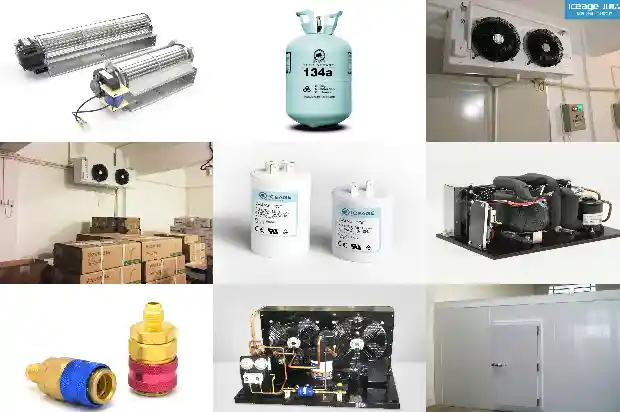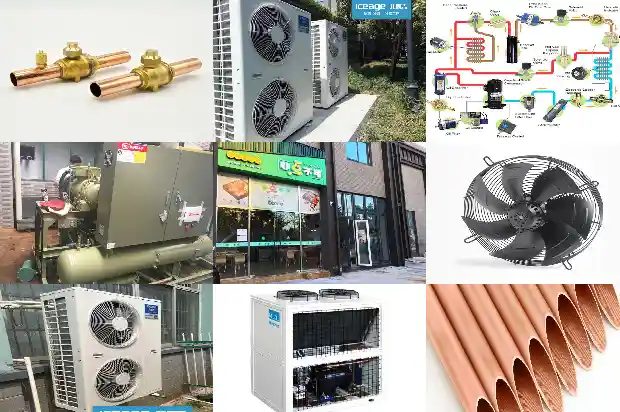Common Fault Causes and Replacement of Multi-connected Unit Compressors
2025-02-28
- High-temperature Protection of Multi-connected Unit Compressors
The general reason for the high-temperature protection of the compressor is that the suction volume of the compressor is insufficient or there is no suction volume. Summarized, there are the following four reasons:
1.1. The system lacks refrigerant. The temperature at the top of the compressor and the exhaust temperature are relatively high. The return air pipe may be frosted, and the return air pressure and current are low. Adding refrigerant can solve this problem.
1.2. The filter screen of the total return air pipe of the outdoor unit is blocked. The temperature at the top of the compressor is too high, while there is basically no temperature and pressure in the exhaust. It cannot push the four-way valve to change direction during heating; the pressures at the two shut-off valves of the gas and liquid pipes are basically the same; the entire part of the total return air pipe after the filter is frosted. Solution: If it is a dirt blockage, cleaning the filter screen of the total return air pipe can solve it; if it is an ice blockage, a filter should be used to remove the moisture in the system.
1.3. The filter screen of the compressor return air pipe is dirty and blocked. The temperature at the top of the compressor is very high, but the exhaust temperature is not high. The temperatures at the tops of one or several other compressors are very low; the reason is that this faulty compressor cannot suck in refrigerant, causing the refrigerant to flow partially to other compressors, resulting in an excessive suction volume of other compressors. The suction pipe of this faulty compressor can be welded off and the suction filter screen can be cleaned.
1.4. The filter screen of the compressor return air pipe is ice-blocked. The temperature at the top of the compressor is very high, but the exhaust temperature is not high. The temperatures at the tops of one or several other compressors are very low; however, after the compressor stops and restarts, the moisture may migrate to the return air filter screen of another compressor, leading to protection.
Solution: If the ice blockage in the system is not very serious, a dry filter can be used to remove the moisture in the system. If the ice blockage is very serious and there is a large amount of moisture in the system, it is basically difficult to remove the moisture with a dry filter. The thorough method is to replace the refrigeration oil and refrigerant containing moisture in the system and flush the system with dry nitrogen. - Compressor Winding Burnout
Fault manifestation: The compressor is protected, the compressor does not start, the compressor trips as soon as it starts, and the resistance value measured by a multimeter shows infinity or a short circuit.
Fault reasons and solutions:
2.1. Abnormal wear of the compressor.
2.
2. Melting or abnormality of the contactor contacts
2.3. Power supply phase loss or abnormal voltage
2.4. Insufficient motor cooling - Compressor Winding Short Circuit to the Ground
3.1. Fault manifestation: The compressor is protected, the compressor does not start, the compressor trips as soon as it starts, and a short circuit to the ground is measured at the wiring terminal with a multimeter.
Fault reason: Abnormal wear of the compressor causes the metal chips after wear to damage the insulation layer of the coil, resulting in a short circuit of the winding to the ground. In addition, during installation, copper chips, oxide scales or sundries entering the interior of the compressor will also cause this. - Compressor Liquid Hammer
4.1. Fault phenomenon: Compressor starting failure; the compressor cannot run or there is a strong mechanical collision sound during operation.
Reasons for occurrence: The lubricating oil containing a large amount of liquid refrigerant has a low viscosity and cannot form a sufficient oil film on the friction surface, resulting in rapid wear of the internal moving parts of the compressor. In addition, excessive addition of refrigerant leads to a large amount of liquid return in the system. It should also be noted that if the indoor unit fan of the air conditioning system does not rotate, the air volume is small, the air duct is blocked, the filter screen or heat exchanger is dirty, resulting in incomplete evaporation of the refrigerant, which will also cause this. - Faults and Handling of Multi-connected Unit Compressor Replacement
It is not recommended to directly replace the compressor after it is burned out. The following matters should be noted during replacement: - Collection of compressor oil: Remove the faulty compressor and pour out the compressor oil. Check the oil quantity and oil quality. Under normal circumstances, the refrigeration oil will flow out from the exhaust pipe after the compressor is laid down laterally. If no oil flows out or the oil quantity is very small, it indicates that the compressor is short of oil. To avoid impurities depositing at the bottom of the compressor, shake the compressor before pouring the oil.
- Check whether the poured oil is black and carbonized, and whether there are impurities such as copper chips and oxide scales in the oil. The normal refrigeration oil is clear and transparent. After the unit operates normally for a period of time, it will be slightly yellowish, but it should remain transparent.
- Inspection of the main pipelines: Check the total return air pipe of the outdoor unit, the filter of the oil return capillary tube assembly and the filter screen of the compressor return air pipe to see if there are obvious impurities.
- Treatment of the oil in the tank: Due to the structural reasons of the oil separator and the low-pressure tank, it is difficult to directly pour out all the oil inside completely. To ensure that the oil is poured out cleanly, a rubber hose can be used to suck it, and then it can be flushed with high-pressure nitrogen. It is recommended to directly replace the tank with a new one.
- Cleaning of the indoor pipelines: If the refrigeration oil pollution is very serious, each indoor unit must be thoroughly cleaned. The method is as follows: Remove the throttling components of the indoor unit and the connecting pipes of the indoor unit separately; Clean the indoor unit, the throttling components and the connecting pipes of the indoor unit separately with high-pressure nitrogen; if the filter of the throttling component is seriously dirty and blocked, it is recommended to replace the throttling component.
- Add the correct compressor oil. Usually, mineral oil is used for R22, and POE synthetic oil is used for R410A. The two cannot be used interchangeably.
Related Articles
- How to Inspect and Troubleshoot the Faults of the Control Valve in the Cold Storage?
- Common Faults in Refrigeration Systems and Handling Methods
- What Are the Common Causes of High - pressure Faults in Chillers?
- Basic Faults and Preventive Maintenance of Water - cooled Units
- Composition and Common Faults of Screw Refrigeration Compressors
- Common Faults and Solutions of Central Air - conditioning Chiller Units
- Common Faults of Industrial Chillers
- Common Faults and Corresponding Solutions of Chillers During Use
- Analysis and Troubleshooting of Common Faults in Air - source Heat Pumps
- Maintenance Methods for Faults in Screw Refrigeration Air - conditioner Compressors
- Common Faults and Troubleshooting Methods of the Moving Mechanism of Piston Compressors
- Analysis of Common Faults in Compressor Overcurrent and Burnout
- What are the reasons for the inactivity of the automotive air conditioning compressor? What are the common faults?
- Common Faults of HVAC Fan Coil Units
- Common Fault Repair of Frozen Cold Storage
- Common Operating Faults and Treatment Methods of Centrifugal Compressors
- Common Four Faults and Replacement Methods of Scroll Compressor
- Analysis of Refrigeration Compressor Motor Faults
